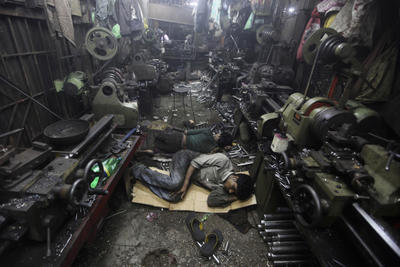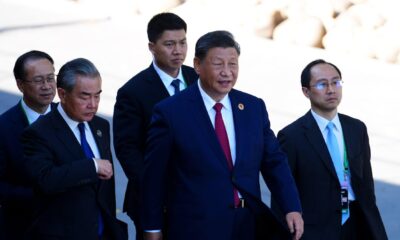Asean
Export-oriented FDI can jumpstart Indian manufacturing

Authors: Abhirup Bhunia, Institute of Economic Growth and Geethanjali Nataraj, Observer Research Foundation
Addressing a joint session of parliament, Indian president Pranab Mukherjee laid out the roadmap of the new Modi government by emphasising three distinct economic policy thrusts: FDI, jobs and manufacturing. Talk of encouraging investment — including by foreign investors — and boosting labour-intensive manufacturing is not new. Scholars such as Arvind Panagariya have long attributed India’s poor performance in manufacturing to the lack of suitable policy designed to utilise the country’s abundant unskilled labour force.
But while utilising the labour force should not amount to exploitation or curtailing democratic rights of workers, archaic labour laws intended to be labour-friendly have had the opposite effect. The problem is one of means and ends. Current labour laws in India require firms of over 100 employees to obtain government permission to sack employees, even if they are unproductive. Furthermore, firms find it difficult to exit in the face of financial loss, unprofitability or any other good reason to shut up shop. These and other restrictive clauses discourage firms from investing in Indian manufacturing.

In 2013, the manufacturing sector contributed only about 15 per cent to India’s GDP, the lowest in a decade. In fact, for several decades the manufacturing sector’s contribution to GDP has remained stagnant at 17 per cent. An underdeveloped industrial sector leaves herds of unskilled Indian youth jobless, giving credence to the possibility of an impending demographic disaster.
So what can be done about it? Reforming labour laws and soliciting export-oriented FDI — something the United Progressive Alliance did not do in the ten years it was in power — could be a good place to start.
In India there are an additional 10 million low skilled workers every month. To create sufficient jobs, large scale manufacturing needs to expand. For this to happen, India needs to become an attractive place in which to undertake manufacturing, and from which to export. In short, it has to become a hub of manufacturing for global export, not just domestic consumption.
Export-oriented FDI has the potential to vault India into the league of industrial economies: a stage which it allegedly skipped on its way to becoming a post-industrial service-based economy. Unlike the predominant market-seeking FDI, export-oriented FDI is labour — and employment — intensive. In 2001, foreign affiliates accounted for only five per cent of India’s total exports. In the same year in China, foreign invested enterprises made up 50 per cent of total exports. In China export obligation is mandatory for foreign investors. This is not the case of India. Export obligation for FDI should be introduced in India to enhance exports.
Export-oriented FDI requires quality physical infrastructure. Thus, a major bottleneck of poor infrastructure must first be dealt with. In this area, massive state investment combined with private sector partner support can rescue India from this sorry state.
From high speed trains to upgrading ports to power sector reforms, Narendra Modi has so far made the right noises. Given that uninterrupted power and seamless transport infrastructure are two crucial demands of the manufacturing industry, it is a good sign that energy and infrastructure form the core of the new cabinet’s economic policy focus.
Modi, widely seen to be a clean pair of hands and a tough taskmaster, is likely to ensure a corruption-free government. At the same time, transparency and an end to unchecked discretionary powers will help to gain the faith of the corporate sector, which has held back investment plans over the last few years of policy paralysis. Once infrastructure is in place, trade and transactions costs will fall, giving a further boost to manufacturing and exports.
In terms of labour cost, India is not at a disadvantage relative to China or East Asia. India’s wage levels are more or less at par with these economies. Additionally, India has one of the best stocks of raw materials in the world and an abundance of workers. Thus as far as factor endowments are concerned, India possesses the bedrock of a thriving manufacturing sector.
Yet it would be irrational to have a single-minded focus on low-skill manufacturing in India at a time when the country has already made strides in the services sector, including in high value-added services. What is needed now is for India to treat manufacturing and services as the two equally important pillars of its economic foundation.
The government should focus on labour-intensive manufacturing for the vast swathe of the low- to medium-skilled populace, while simultaneously undertaking a national skills mission, boosting research and development spending and improving the quality of education at all levels. FDI on its own accord will contribute to some of the above while developing useful production linkages with the local economy.
As in China, export-oriented FDI can help fortify India’s domestic manufacturing base. Much of the recent sophistication and value addition in China’s manufacturing export basket is also largely due to FDI in the sector. A synchronisation of India’s export and FDI policies is needed. This can be achieved by increasing FDI in export-oriented sectors like gems and jewellery, light engineering, goods and textiles, among others. Up till now, FDI in India has been concentrated in telecom, infrastructure and financial services.
Eventually rising exports, on the back of growing export-oriented FDI, will help India address its troubling trade deficit. One of China’s great success stories — and a reflection of effective policymaking in that country — is that it built a trade surplus by exploiting FDI sourced from various parts of the world. Prime Minister Modi often talked of rivalling China on many issues, including commerce, during his election campaign. Encouraging export-oriented FDI would be a winning strategy to translate those assertions into meaningful action.
Abhirup Bhunia is a research analyst at the Institute of Economic Growth in New Delhi.
Geethanjali Nataraj is a senior fellow at the Observer Research Foundation in New Delhi.
Here is the original post:
Export-oriented FDI can jumpstart Indian manufacturing
Asean
Deadly Floods and Landslides Strike Indonesia and Thailand – Vietnam Plus

At least seven people were killed, two others were injured and some were likely to be missing after flash floods and landslides hit the Indonesian eastern province of Maluku on the morning of August 25, according to the locality’s disaster management and mitigation office.
Heavy rainfall, which began on August 24, has triggered the disasters in Ternate city. Many local residents are in urgent need of support, authorities said.
Soldiers, police, local search and rescue personnel, disaster management staff, and volunteers are all involved in the ongoing rescue efforts, which include evacuating those trapped by the landslides and recovering materials from homes swept away by the floods.
Meanwhile in Thailand, local authorities reported that the death toll from a landslide in the popular resort province of Phuket on August 23 has risen to 13, including a Russian couple.
Source : Floods, landslides kill many in Indonesia, Thailand – Vietnam Plus
Asean
Tug of War in Southeast Asia: Can ASEAN-China Dialogue Shift the Scales Toward Peace? – An Analysis

The ASEAN-China dialogue is vital for regional stability, addressing economic cooperation and security challenges, particularly in the South China Sea, amidst significant geopolitical complexities and ongoing territorial disputes.
ASEAN-China Dialogue: A Path Towards Cooperation
The ASEAN-China dialogue plays a pivotal role in Southeast Asia’s diplomacy, fostering economic collaboration while addressing security challenges. Despite advances, particularly in managing tensions in the South China Sea, significant barriers remain to achieving lasting peace and stability in the region. ASEAN’s capacity to maintain its unity and centrality is crucial amidst complex power dynamics involving China and other global players.
Navigating Tensions and Economic Relations
A pressing concern within this dialogue is the South China Sea territorial disputes, which involve multiple ASEAN states and China. The militarization of the area raises alarm among regional stakeholders, necessitating urgent negotiations for a Code of Conduct (COC) to manage conflicts. Additionally, the growing economic interdependence fostered by initiatives like the Regional Comprehensive Economic Partnership (RCEP) strengthens ASEAN-China ties, yet it also raises concerns about potential political leverage influencing member states’ autonomy.
The Challenge of Regional Stability
While the ASEAN-China dialogue offers a framework for promoting peace, its effectiveness is conditioned by broader geopolitical contexts, including China’s rivalry with the United States. The success of this dialogue rests on sustaining a commitment to multilateralism and peaceful dispute resolution. As ASEAN adapts to these complex dynamics, it must reinforce its unity and cooperative strategies, ensuring the region’s stability amid evolving challenges.
Source : Tug Of War In Southeast Asia: Will ASEAN-China Dialogue Tip The Balance Towards Peace? – Analysis
Asean
Cambodia Invites Business Leaders to Join the 21st China-ASEAN Expo in Nanning

Cambodia invites businesspeople to the 21st China-ASEAN Expo in Nanning, promoting trade and investment with incentives like hotel coupons and networking opportunities in various sectors.
Cambodia Invites Participation in CAEXPO 2024
Cambodia is actively encouraging business leaders, investors, and service providers to participate in the upcoming 21st China-ASEAN Expo (CAEXPO), set to take place from September 24-28 in Nanning, China. According to a Ministry of Commerce announcement, CAEXPO serves as a vital platform for trade and investment collaborations between ASEAN nations and China.
To facilitate Cambodian participation, the Ministry invites interested individuals to apply as Trade Visitors by August 31, 2024. Participants will benefit from hotel coupons, dining vouchers, and shuttle services to the expo venue. Furthermore, attendees can engage in business matchmaking in sectors such as food processing, digital technology, and renewable energy products.
Kin Phea, from the Royal Academy of Cambodia, emphasized the advancements in China-ASEAN relations, particularly concerning economic cooperation, tourism, and cultural exchanges. He noted that both sides have become each other’s largest trading partners, enhancing collaboration through the Belt and Road initiative, focusing on infrastructure and sustainable development.
Source : Cambodia encourages businesspeople to partake in 21st China-ASEAN Expo in Nanning












